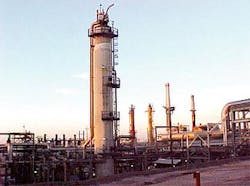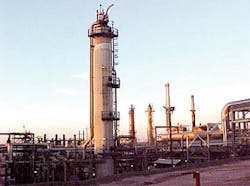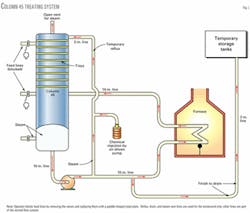Phillips 66 Co. (now ConocoPhillips) completed the shortest turnaround of its gas-plant receiver at its Borger, Tex., refinery and NGL center using a combination of surfactants, enzymes, an oxidizer, and a high flash-point solvent.
null
An area about 4,340 cu ft in Column 45 was chemically decontaminated in 12 hr; the receiver was returned to operation in only 3 days at a cost of $14,900.
In a previous turnaround, a crew of 20 men worked for 3 days to chisel off deposits that resisted chemical treatment for a total turnaround time of 5 days at a cost of $34,500 ($24,000 in labor and $9,500 in chemicals).
Phillips treated Column 45, an initial deoiling column in the refinery's gas plant (Fig. 1), during an annual shutdown for maintenance and removal of scale, other deposits, and contaminants. The refiner cleaned the column with a combination of circulating fluid and steam that delivered three components:
- A surfactant-enzyme (SE) mixture.
- A high flash-point solvent.
- An experimental oxidizing chemical.
The oxidizer converts contaminating sulfides to sulfates, which are water soluble. This allows for easy removal and waste handling. The SE mixture removes dangerous gases from vapor spaces and allows for quick entry.
- The refiner had these goals for the column decontamination process:
- Lower the benzene content to less than 1 ppm.
- Reduce the H2S content to less than 1 ppm.
- Decrease the lower explosion limit to nearly zero.
- Render Column 45 safe for human entry.
- Return Column 45 to service within 48 hr.
Decontamination challenges
Column 45 was installed in 1980. During early operations, NGL feedstock was first sent through a cleanup unit to remove the heaviest components. Even with the cleanup unit, Column 45 required annual shutdowns for decontamination.
The refiner used surfactants to chemically clean the column. This process removed oils but left deposits that required physical removal. A further complication was that personnel had to wait several hours before it was safe to enter the column. This chemical cleaning method was discontinued due to these problems.
In 1994, Phillips started using an SE method to decontaminate the column and used it routinely until 1999, at which time the plant was reconfigured so that NGL feedstocks were no longer cleaned up before entering Column 45. The column's bottom sections then developed thick coats of hard iron sulfide deposits as well polymeric deposits.
In 2000, the SE treatment method was ineffective for the polymeric and iron sulfide deposits, so Phillips reverted to physical removal of the deposits with hammers, chisels, and whisk brooms. About 20 men worked 3 days to achieve the turnaround.
2001 turnaround
In 2001, Phillips opted for a new chemical system designed to remove the hard iron sulfide deposits and polymeric deposits that had previously resisted hydroblasting and chemical removal. The new system included three components—an SE mixture, solvent, and oxidizer—conveyed by 190° F. water and live steam.
SE combination
The water-based SE combination emulsifies and demulsifies hydrocarbons without external emulsion breakers. It oxidizes H2S and pyrophoric iron, and is a wetting agent for suspended solids and vessel walls.
Solvents are sometimes required to adjust sludge gravity so phase separation can occur on the surface of the water phase, and to control viscosity. The chemistry is nontoxic, nonhazardous, biodegradable, nonflammable, and contains no volatile hydrocarbons.
Solvent
Column 45's treatment required a high flash-point solvent with the SE mixture to dissolve the iron sulfide deposits and polymeric coating. The solvent is commonly used to dissolve and disperse heavy hydrocarbon sludges in vessels; remove asphalt, heavy lube oil, and heavy residuals; remove unit bottoms from vessels; and clean lines and tanks. It is biodegradable.
Oxidizer
The oxidizer used in Column 45 was a stabilized mineral peroxide designed to oxidize resistant compounds, including tetrathionates and thiosulfates, that may remain in vessels after decontamination.
The process oxidizes these residual compounds to sulfates that are water soluble, which makes waste removal, handling, and disposal much easier. The oxidizer allows the SE product to decontaminate and treat small pores and difficult sludges.
The oxidizer is pH-neutral and is safe with all known metallurgies. Waste water containing the recommended concentration of the oxidizer is not harmful to most waste-water plants.
Fig. 2 shows the treatment piping arrangement. The 10-in. lines represent permanent piping. The 2-in. lines are temporary lines for the treatment process and are removed when the treatment is complete. The temporary reflux line takes treatment fluid to the column's top where it can contact the trays and flow downward to contact live steam.
In preparation for the treatment, Phillips:
- Assured that all non-Phillips members of the decontamination team completed an 8-hr safety course.
- Removed valves connecting the column to feed lines and blinded the feed lines with a single piece steel plate (Fig. 2).
- Arranged for a steam source to heat wash solutions to 190-210° F. and maintain that temperature range during the treatment process.
- Installed adequate vents to prevent excessive pressure or vacuum buildup on units and components during filling, circulation, and draining.
- Prepared for waste disposition based on the amount of oil and solids.
- Provided sample points and sample-catch bottles.
- Provided water with a pH range of 6-8.5.
The 2-in. reflux line was fitted with a 1-in. port that allowed an air pump to inject the SE mixture, followed immediately by the solvent. The SE and solvent circulated for 3 hr at 190° F.
null
The mixture was routed through a furnace to maintain a 190° F. temperature. After an additional 3 hr of circulation, oxidizer injection began. Benzene levels were tested every 2 hr. When benzene levels fell to 1 ppm, the column was drained into temporary storage tanks and later released to biotreatment.
The iron sulfide and polymeric deposits that had fouled the column were reduced to powder and were washed away with water. Column 45 was placed back in service 72 hr later.
Laboratory testing, analysis
After the year 2000 turnaround, Phillips opened the column to find that it was still dirty. Phillips decided to mechanically clean the unit to return it to production as fast as feasible. Samples of the SE product and contaminants were sent to a United Laboratories International LLC laboratory for analysis and recommendations.
Contaminants were dry, finely divided solids. Using the samples, United Laboratories developed a method to decontaminate and clean Column 45. The research procedure involved:
Cleaning the samples with SE and a high flash point solvent in a 190° F. water solution. In early experiments, the stabilized mineral peroxide oxidizer would not act or react with the solids.
- Circulating a stabilized mineral peroxide oxidizer with the SE chemicals, solvents, and solids that pulled the solids back into suspension or slurry. The oxidizer created some foaming on the solids, which appeared to help free them and pull them into suspension.
- Circulating the mixture for about 1 hr, at which time the solids began to fall out of suspension.
- Adding another 1% solution of oxidizer and circulating for an additional 2 hr, when additional foam was released.
- Finding that the solids released free black oil during the solvent action. After 2 hr of circulation, the solution settled and fluid was poured off. Sludge particles had broken down primarily into a dust slurry with some larger particles.
This laboratory analysis led to the 2001 turnaround procedure.
The authors
Audie Hatton is the NGL shift team leader at the ConocoPhillips Borger Refinery and NGL Process Center, Borger, Tex. Hatton has 23 years' experience in refining, specialty chemicals, and refinery turnarounds.
David Conley is a technical specialist with United Laboratories International LLC, Houston. He has 13 years' experience performing turnkey turnarounds in the refining and petrochemical industry.
Bevan Collins is the international technical manager for United Laboratories International LLC. He has 19 years' experience in the oil and gas production industry and 8 years' experience in the refining and petrochemical industry. He holds a degree in petroleum engineering from the University of Wyoming, Laramie.





